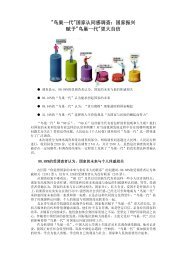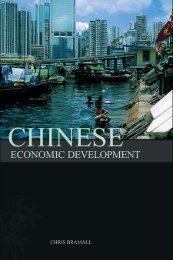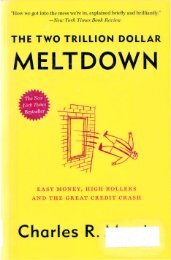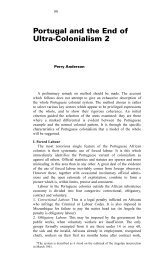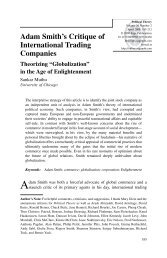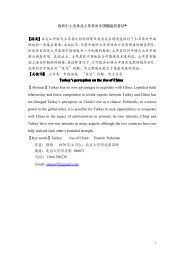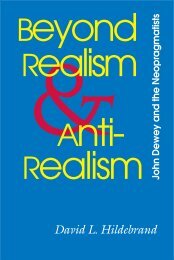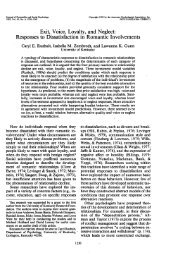Battle for China's Past : Mao and the Cultural Revolution
Battle for China's Past : Mao and the Cultural Revolution
Battle for China's Past : Mao and the Cultural Revolution
Create successful ePaper yourself
Turn your PDF publications into a flip-book with our unique Google optimized e-Paper software.
THE BATTLE OF CHINA’ S HISTORY<br />
The following examples show how <strong>the</strong> profits are shared when<br />
<strong>for</strong>eign firms operate in China. A Barbie doll may sell in <strong>the</strong> US market<br />
at a retail price of US$10, but its FOB price from China is only US$2, of<br />
which US$1 is <strong>for</strong> management <strong>and</strong> transportation costs. Of <strong>the</strong> o<strong>the</strong>r<br />
US$1 spent in China, 65 cents are spent on materials. Only 35 cents are<br />
left <strong>for</strong> <strong>the</strong> Chinese workers to share. Similarly, Han Yanming (2004)<br />
notes that a factory in Suzhou produces 20 million computer mouses a<br />
year <strong>for</strong> Logitech International SA to sell to <strong>the</strong> US market <strong>for</strong> US$40<br />
apiece. Logitech takes US$8, distributors <strong>and</strong> retailers take US$15, <strong>and</strong> a<br />
fur<strong>the</strong>r US$14 is paid <strong>for</strong> <strong>the</strong> materials <strong>and</strong> parts. The Chinese side gets<br />
only US$3, which includes <strong>the</strong> cost of labour, electricity, transportation<br />
<strong>and</strong> so on.<br />
Ano<strong>the</strong>r example of how <strong>the</strong> transnational capitalist chain exploits<br />
Chinese labour is a case study reported by China Labor Watch. A Puma<br />
shoe factory run by a Taiwan businessman employs about 30,000 workers<br />
in Guangdong; <strong>the</strong> retail price of a pair of its shoes in <strong>the</strong> United<br />
States ranges from US$65 to US$110. The average Chinese worker gets<br />
paid US$1.09 per pair, while Puma spends US$6.78 per pair on advertising.<br />
The retail value of <strong>the</strong> shoes made by a worker in one week equals<br />
all <strong>the</strong> money paid to him or her <strong>for</strong> a whole year. The average hourly<br />
wage rate paid to a Chinese worker is 31 US cents, while <strong>the</strong> profit <strong>the</strong><br />
company makes from each Chinese worker is US$12.24 per hour. The<br />
workers regularly have to work from 7.30am to 9.00pm, but sometimes<br />
have to work overtime until 12pm with no increase in <strong>the</strong> hourly rate.<br />
Sometimes <strong>the</strong>y do not even get paid at all <strong>for</strong> overtime. They have a<br />
one-hour break <strong>for</strong> lunch <strong>and</strong> an hour <strong>and</strong> a half <strong>for</strong> dinner. They sleep<br />
in <strong>the</strong> factory compound, with twelve people in one room <strong>and</strong> one bathroom<br />
<strong>for</strong> 100 people to share. They are not allowed to talk at work <strong>and</strong><br />
cannot leave <strong>the</strong> factory compound without permission. The penalty <strong>for</strong><br />
arriving five minutes late at work is <strong>the</strong> deduction of three hours’ pay.<br />
There are no regulations on workplace health <strong>and</strong> safety conditions in<br />
<strong>the</strong> factory (China Labor Watch 2004).<br />
Joint ventures not only make profits but also shift production relations<br />
in China. In an in-depth study of two key model joint ventures,<br />
Chin (2003) finds that <strong>the</strong>re has been a significant shift to capitalist<br />
social relations of production in China’s joint venture sector. The study<br />
suggests that China’s <strong>for</strong>eign-invested sectors operate according to <strong>the</strong><br />
logic of capitalist accumulation, or ‘accumulation by dispossession’<br />
coined by David Harvey, <strong>and</strong> that a hegemonic regime of labour<br />
control has developed in <strong>the</strong>se ventures. The 1995 Chinese Labour Law<br />
has specific stipulations to protect workers’ rights <strong>and</strong> working conditions<br />
(Du Guang 2005). But privilege <strong>and</strong> concessions are allowed to<br />
exempt <strong>for</strong>eign companies from <strong>the</strong> Labour Law. Such labour concessions<br />
were first made in special economic zones, but were later<br />
[ 181 ]





